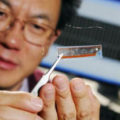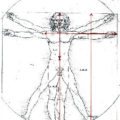Princeton electrical engineers have invented a technique for making solar cells that, when combined with other recent advances, could yield a highly economical source of energy.
The results, reported in Nature, move scientists closer to making a new class of solar cells that are not as efficient as conventional ones, but could be vastly less expensive and more versatile. Solar cells, or photovoltaics, convert light to electricity and are used to power many devices, from calculators to satellites.
The new photovoltaics are made from “organic” materials, which consist of small carbon-containing molecules, as opposed to the conventional inorganic, silicon-based materials. The materials are ultra-thin and flexible and could be applied to large surfaces.
Organic solar cells could be manufactured in a process something like printing or spraying the materials onto a roll of plastic, said Peter Peumans, a graduate student in the lab of electrical engineering professor Stephen Forrest. “In the end, you would have a sheet of solar cells that you just unroll and put on a roof,” he said.
Peumans and Forrest cowrote the paper in collaboration with Soichi Uchida, a researcher from Nippon Oil.
Because of these qualities, researchers have pursued organic photovoltaic films for many years, but have been plagued with problems of efficiency, said Forrest. The first organic solar cell, developed in 1986, was 1 percent efficient – that is, it converted only 1 percent of the available light energy into electrical energy. “And that number stood for about 15 years,” said Forrest.
Forrest and colleagues recently broke that barrier by changing the organic compounds used to make their solar cells, yielding devices with efficiencies of more than 3 percent. The most recent advance reported in Nature involves a new method for forming the organic film, which increased the efficiency by 50 percent.
Researchers in Forrest’s lab are now planning to combine the new materials and techniques. Doing so could yield at least 5 percent efficiency, which would make the technology attractive to commercial manufacturers. With further commercial development, organic solar devices would be viable in the marketplace with 5 to 10 percent efficiency, the researchers estimated. “We think we have pathway for using this and other tricks to get to 10 percent reasonably quickly,” Forrest said.
By comparison, conventional silicon chip-based solar cells are about 24 percent efficient. “Organic solar cells will be cheaper to make, so in the end the cost of a watt of electricity will be lower than that of conventional materials,” said Peumans.
The technique the researchers discovered also opens new areas of materials science that could be applied to other types of technology, the researchers said. Solar cells are made of two types of materials sandwiched together, one that gives up electrons and another that attracts them, allowing a flow of electricity. The Princeton researchers figured out how to make those two materials mesh together like interlocking fingers so there is more opportunity for the electrons to transfer.
The key to this advance was to apply a metal cap to the film of material as it is being made. The cap allowed the surface of the material to stay smooth and uniform while the internal microstructure changed and meshed together, which was an unexpected result, said Forrest. The researchers then developed a mathematical model to explain the behavior, which will likely prove useful in creating other micromaterials, Forrest said.
“We’ve shown a very new and general process for reorganizing the morphology of materials and that was really unanticipated,” Forrest said.


















Comments are closed.